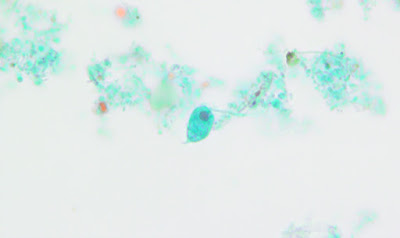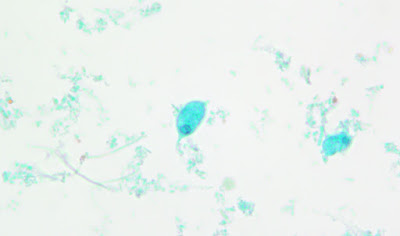Answer to the Parasite Case of the Week 729: Trophozoites of Chilomastix mesnili
Below is an answer written by Dr. Jacob Rattin (@EternalStudying):
This non-pathogenic flagellate has pear-shaped trophozoites that are 6 – 24 μm long with a longitudinal spiral groove running along the body (not seen in this specimen). If visualized in a fresh prep, the motility may allow the spiral groove to be seen as the organism turns (see Case 475). The trophozoite has one nucleus (arrowhead), usually at the anterior end, with an eccentric karyosome and a cytostome (oral groove) close by. The posterior end tapers to a point (arrow).
Differentiating C. mesnili trophozoites from other non-pathogenic flagellates such as Enteromonas hominis, Pentatrichomonas hominis, and Retortamonas intestinalis can be quite difficult. Thankfully, these organisms are non-pathogenic. However, the following features may be useful in teasing apart these fun flagellates!
Enteromonas hominis trophozoites measure 5 – 7 µm long with one nucleus and three anterior flagella and one posterior flagellum. It has a single nucleus with a large karyosome. There is no cytostome which helps to differentiate it from C. mesnili.
Retortamonas intestinalis are 4 – 10 µm long with an ovoid trophozoite form with a cytostome at the anterior half that is bordered by a fibril. The single nucleus is at the anterior end and has a small karyosome.
Pentatrichomonas hominis. The trophozoites are pyriform in shape, measuring 6 – 20 µm long. They have five flagella, with four directed anteriorly and a fifth directed posteriorly. The fifth flagellum forms the outer edge of an undulating membrane and projects beyond the posterior. A single nucleus is at the anterior end and contains a small karyosome.
Thanks again to Dr. Rattin for taking on the non-pathogenic flagellates! I'm sure you'll agree that he did an excellent job. Thanks also to the laboratory technologist, Marissa Roberts, who took these photos, and to Dr. Anisha Misra at the Cleveland Clinic for her scientific oversight.















